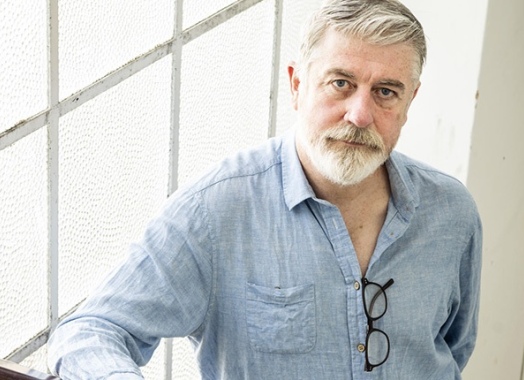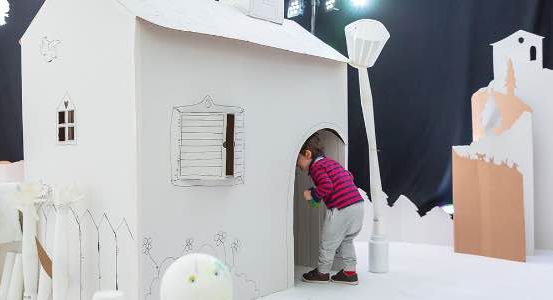
James McLoughlin - Instagram Takeover
September-December 2025
Meet Artist Anne Cradden - Creator of 'Space to Explore' in our First Floor Gallery

Anne Cradden graduated with BA in Fine Art from IADT in Dun Laoghaire in 2005. Her work in sculpture and drawing focuses on material concerns and the experience of three dimensions, and more recently on how making and playing with material and architectural things can create stories. Over the past few years, she has become passionate about arts education, and has made working with children in a range of cultural and educational settings the heart of her practice. Most recently, she was artist in residence for Fingal County Council’s Room 13 project at Tyrrelstown Educate Together National School, where she and the students shared a studio as well as their ideas and experiences. Alongside her own projects, she is currently a Creative Associate with the Arts Council’s Creative Schools program, working with a range of schools in north Dublin on developing their creative practices, policies, and networks.
-----
"When Sarah Beirne, Draíocht's Children & Youth Arts Officer, asked me to make an engagement space for a sculpture exhibition I couldn’t believe my luck. I had previously worked with cardboard for a show at the Lexicon In Dun Laoghaire a few years ago and I had many sketches and models and thoughts about developing these ideas but not enough time and space in between other work. I had also been working as part of a set design collective, Set Square, with my fellow artists Orla Kelly and Andrew Carson, on using physical and sculptural bits and pieces as a prompt to play in the context of theatre for children, in which the way children played with materials and things would lead to them developing a story and eventually a script.
The sculpture project at Draíocht has given me the opportunity – I should say the excuse – to make cardboard sculptures that I had been thinking about for a long time. I began with really nice cube boxes that I had sourced for the theatre project and started to modify them in ways that I thought would be interesting – removing parts, inverting parts, lining them with different materials, creating voids and openings, adding things that would invite a small child to interact with them : feel the different textures, look inside, test how heavy they are, wheel them around, stack them high, take a handle and pull. Before I started making, had thought that these pieces would involve engineering in terms of designing, measuring, cutting precisely, and reassembling; however it was really interesting that in order to make the pieces inviting, I ended up also using very traditional sculptural techniques: sawing, carving, sanding, whittling, squashing, pressing, and manipulating, until they looked and behaved the way I wanted them to. It has been such a liberating experience to work in this experimental way and I don’t want to stop!"
"In order to play and learn, children need to be able to test limits, to ask questions, to experiment with THINGS. What if something is very heavy and we cannot move it? When something is bumpy, how do we explore it? What are ropes for? What can they do? If I pull this, what happens? How does this sculpture make me change how I move, act, feel, interact with others? Do I need someone to help me do what I want to do?
Can we create a sculpture that says ….
Push me?
Pull me?
Squash me?
Lift me?
Stack me?
Sort me?
Spin me?
Drop me?
Roll me?
It’s important that the children be allowed to treat these pieces however they want – to play with them without fear of things getting wrecked or broken. Perhaps the destruction is part of the sculptural process?
When is a sculpture finished? When we have finished being interested in it."
"Making these objects also gave me the chance to go through my stash of interesting materials that I have been collecting for many years, from Recreate (an amazing materials resource that salvages reusable materials from businesses and redistributes them for creative reuse) and other places along the way. When selecting materials both for my own pieces and for the materials that I would invite the children to use, I tried to choose materials based on their material qualities, the interesting textures or shapes or forms. I avoided things that were very colourful as I wanted to focus on their sculptural interest, and I also avoided things where the former use of the thing was obvious – that is, things that already had a name or use in the world, like paper cups - so children would feel as free as possible to use them in whatever way they wanted.
I had some sketches of pieces I had had in mind for a long time, but when I started working with the materials I tried to let them suggest to me what kind of piece they wanted to be used in…if that makes sense! This worked really well and meant that there was a constant queue of ideas for pieces growing in my mind as I went on. This was an experience I hoped to make available in the engagement space for anyone that wanted to try. Because of this it was really important that there be as little time limits in the sessions as possible – we were so lucky to have the physical space to work in, but what is also really important is the time to explore and think before we even decide what it is we want to make."
"In our pop-up lab, the children are invited to make their own sculptures using loads of interesting things I have collected - and they are especially interesting because no one knows why they are in the world or what they are called! This means we can add our own meaning. They are squashy, heavy, rough, floaty, transparent; they can be cut and stacked; they can be joined together and pulled apart.
Adding interactive potential will be magnets, Velcro, string, tape, elastic, rope, hessian, embossed wallpaper, soft fabric, mirrors, hooks, wheels, and weights.
Nothing is precious, but everything is interesting!
I absolutely love heading into the space every day – I usually bring my workshops into schools and other places, but it was lovely being able to have a pop-up workshop for a whole 4 weeks, a place to leave things midway through and come back to after thinking a bit more, to bring my books and read and show them to others, to pin up inspiration, and to chat to everyone who came into the space."
"There’s been so much lovely feedback from both grown ups and children! I have lost count of the times I’ve heard a child say ‘Oh this is so cool!’ - which of course is the highest praise and means that the engagement space is doing what Sarah Beirne and I wanted it to do. We have also had repeat customers over many of the days, which speaks for itself!
The age range of people interacting in the space has been from 4 months to 83 years ... from children on holidays with their grandparents, groups from summer camps, minders with neurodivergent children, theatre professionals on a mentoring course in Draíocht, parents juggling babies and school age kids, teachers doing July provision with children from their classes, friends with visitors from out of town, families using the space as a place to meet up and have fun, teenagers filling in time waiting to meet their friends at Penneys, sisters making stuff for an hour one day and then coming back the next day to make a quick something in 10 minutes, grown-ups working alongside their children and getting as lost in their work as the children are (and suggestions that we have grown up sessions too!), playmates waiting patiently for a helping hand from the artist, neighbours having a cup of tea and a chat as they encourage the children, and one very lovely lady bringing me a cup of tea to keep me going as I wielded the glue gun!
For me, its this whole process of meeting, talking and experimenting together that means the project is a success, rather than the things that are made (although those are great too!) And it’s been so lovely to be able to say to everyone as they leave, ‘Call in any time!’ and for them to reply ‘Oh we’ll be back alright, don’t worry!’ "
"As part of the NEST mentoring week at Draíocht, we made a special exception and allowed grown-ups to have a go in our sculpture lab! The actors and writers in the NEST programme will be getting to know a range of different people in the community and will then write a theatre piece inspired by them. Letting them loose in the sculpture lab, they’ll be able to see first-hand how artists can use creative play to engage with children. Working together on making things can be a hugely effective way to approach and express thoughts, feelings and experiences, as well as to tell stories (It’s also a just a lot of fun.)"
"Next up for me is to apply for funding for two projects that I have had in mind for a while:
Along with Set Square collective, I hope to collaborate with a theatre to further develop the idea of sculptural and architectural pieces as impetus to storytelling and theatre making – putting the cart before the horse, we’ll be putting the set before the play! What happens if you put two groups of people on either side of a door? If there is a wall between us, how do we feel? How does talking to someone through a window affect the conversation? What if an audience can see both people in a theatre space but they cannot see each other? What do we do if we have a ladder? How do 10 children work out how to share one swing? How do we deal with obstacles when we need to get from one side of a space to the other?
As I am also making an epic move to live and work Donegal this summer, I’m hoping to set up an engagement space there like the one we have been so lucky to have in the upstairs gallery – the Draíocht space has been like a test bed for an idea I have had to set up a Saturday art club where I can provide space, encouragement, and access to equipment and materials, and local children and young people can drop in and read and think and talk and make stuff for a few hours every Saturday. If we are lucky it will function just like our Draíocht sculpture lab! "






Subscribe to our mailing list to get our latest news and events sent straight to your inbox.
Join our mailing list